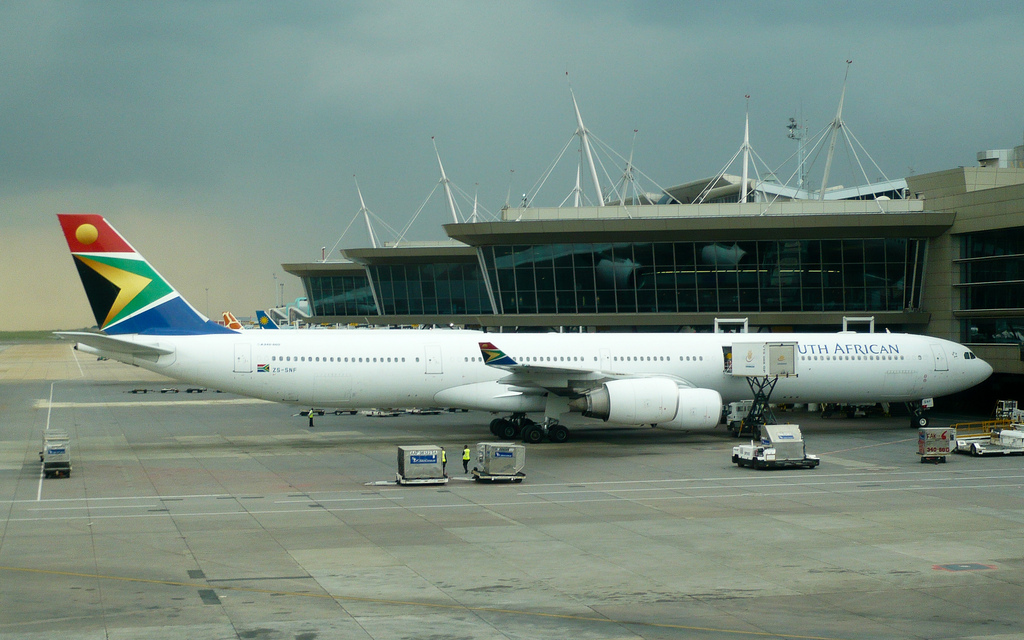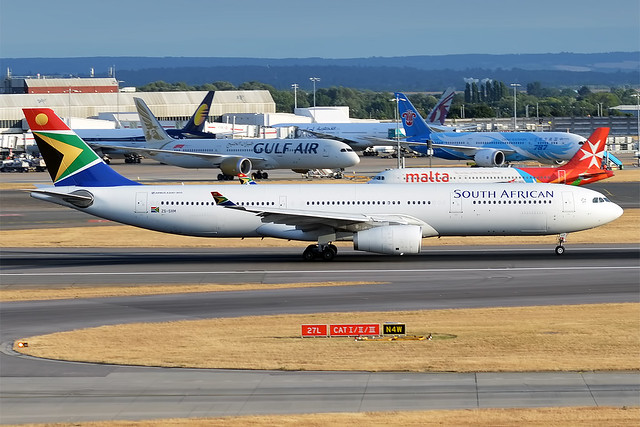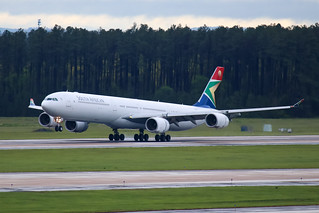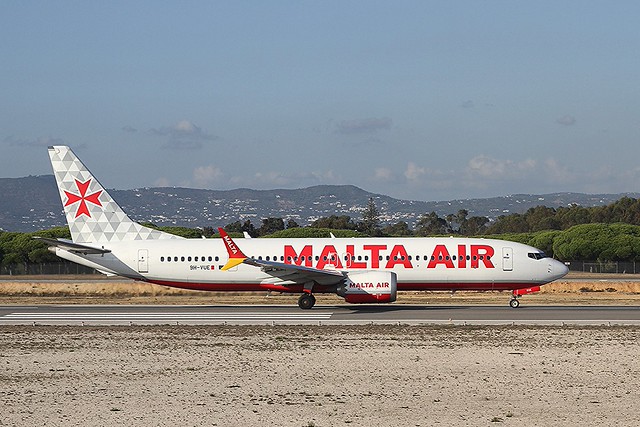SAA A346 over Switzerland on Nov 6th 2018, overspeed, dual ADR failure
Last Update: July 17, 2023 / 16:51:15 GMT/Zulu time
Incident Facts
Date of incident
Nov 6, 2018
Classification
Incident
Airline
SAA South African Airways
Flight number
SA-260
Departure
Johannesburg, South Africa
Destination
Frankfurt/Main, Germany
Aircraft Registration
ZS-SNF
Aircraft Type
Airbus A340-600
ICAO Type Designator
A346
Germany's BFU reported the aircraft encountered an overspeed event, rated the occurrence a serious incident and opened an investigation.
According to information The Aviation Herald received the aircraft sustained multiple system faults in flight including the failures of Air Data Reference 2 (ADR2) and 3 (ADR3) associated with the autopilot and autothrust disengaging and the fall back of the FBW into alternate law.
The occurrence aircraft remained on the ground for 3 days, then returned to Johannesburg as flight SA-4263.
On Mar 1st 2019 South Africa's CAA (SACAA) reported they have opened an investigation into a SAA pilot, who had allegedly been flying commercial aircraft with a forged air transport pilot license for more than 20 years. The matter came to light during the investigation into the flight SA-206 (editorial note: this is in error, correct flight number was SA-260) from Johannesburg to Frankfurt in November 2018, which had a reportable incident in Swiss Airspace. The pilot in question has already resigned.
Sources in South Africa state, the pilot held a correct and valid CPL. After joining SAA in 1994 he was expected to upgrade to ATPL within 5 years by SAA (but not by regulations or authorities), however failed to do so and forged his ATPL. The pilot refused to be upgraded to captain when asked and remained first officer.
Germany's BFU reported in their November Bulletin that the aircraft was enroute at FL380 with winds from 215 degrees at 65 knots (tail wind). When crossing the main ridge of the Alps near the Clariden peaks (Switzerland) the winds changed to 175 degrees at 15 knots, with the windspeed reducing from 50 knots to 15 knots in 15 seconds, causing the airspeed increase from 0.82 to 0.88 mach, the overspeed warning activated for 8 seconds, the speed increased further to 0.89 mach before reducing again to 0.86 mach. 4 seconds after the overspeed warning activated the autopilot was disengaged, the captain (59, ATPL, 17,694 hours total, 16.5 hours on type) took control of the aircraft, the pitch angle increased from 3.5 degrees to 11 degrees by manual inputs resulting in a vertical acceleration of +1.6G, the aircraft climbed up to 5700 feet per minute. The first officer (61, CPL, 18,532 hours total, 5,274 hours on type) observed a rapid increase of the Alpha Protection speed in his primary flight display and suspected a possible erroneous behaviour of the stall protection. The captain therefore instructed to turn off two air data reference units. In the meantime autothrust had reduced the engine thrust from 1.09 to 0.7 EPR, while the aircraft climbed through FL390 ADR#2 and ADR#3 were turned off, the flight control system changed from normal to alternate law, autothrust disengaged. The crew declared PAN PAN, the pitch angle began to reduce again. At FL400 the IAS had reduced to 203 knots (0.68 mach), the aircraft began to descend, the pitch angle was increased again resulting in a stall warning at 0.7 mach and 7 degress nose up angle of attack. Manual inputs by the left sidestick to lower the nose brought the pitch to below 6 degrees nose up, the stall warning ceased. In the following 23 seconds there were alternating inputs on the side stick to pull the nose up and push the nose down with the pitch ranging from -4.6 degrees (4.6 degrees nose down) to 6.3 degrees nose up pitch with associated angles of attack between 3 and 8 degrees, the stall warning activated three more times for up to 4 seconds. 14 seconds after the last stall warning the engine thrust increased to above 1.00 EPR, the crew declared Mayday, Mayday reporting they had no control [...]. At that point the aircraft was descending through FL370 at 6600 fpm. About 30 seconds later the sinkrate briefly reduced to 100 fpm, in the following 3.5 minutes the aircraft continued to descend before stabilizing at FL340. Subsequently the two ADR units were turned on again and the crew reported they were able to engage autoflight again, about 5 minutes after the onset of trouble. The aircraft landed in Frankfurt about 36 minutes after the onset of trouble.
The BFU reported a second first officer (39, ATPL, 11,453 hours total, 3,901 hours on type) was augmenting the flight crew and was licensed to occupy the left hand seat while acting as relief pilot for the commander. At the time of the occurrence he was seated in the observer seat.
With respect to the captain the BFU stated, he had acquired his ATPL on Nov 19th 1990, the license was valid through Mar 31st 2019. He had completed his training for A340-600 on Oct 29th 2018. A proper medical was presented to the BFU.
With respect to the first first officer the BFU reported he held a valid CPL issued on Jan 20th 2018 by South Africa's CAA valid through Jan 31st 2019. He had completed his training for A340-600 in Feb 2005. The BFU was not presented with a medical by the first first officer.
The second first officer had received his ATPL on Jan 26th 2005 issued by South Africa's CAA, which was valid through Mar 31st 2019. He completed his training for the A340-600 on Aug 17th 2013. A proper medical was presented to the BFU.
The BFU reported that an operations engineering bulletin (OEB) had been issued in 2015 in addition to the FCOM. The OEB describes how to disengage Alpha Protection in case of an erroneous activation by switching two ADR units off, if in straight level flight without any changes in load the indication of the V-Alphaprot increases with increasing mach number. The OEB had been released after it was established that in some case an erroneous activation of the protection had occurred.
A weather model computed the presence of mountain waves in the area of the occurrence.
On Jul 17th 2023 the German BFU released their final report concluding the probable causes of the serious incident were:
The aircraft was in cruise flight at Flight Level (FL) 380 in Swiss airspace, when a change of wind conditions at high altitude caused the exceedance of the maximum operating Mach. The Pilot in Command deactivated the autopilot and steered the aircraft manually into climb. While reaching FL 400, the maximum angle of attack was reached several times and the stall warning activated. The PIC initiated a descent, stabilizing the flight path again at FL 340.
On 16 November 2018, the Swiss Transportation Safety Investigation Board (STSB) delegated the investigation to the German Federal Bureau of Aircraft Accident Investigation.
The investigation determined:
- A rapidly turning wind direction during cruise flight, unpredictable for the flight crew. This caused an overspeed condition.
- The flight crew did not respond to this overspeed condition with the procedure
Abnormal and Emergency Procedures / Misc / Overspeed Recovery.
- The PIC had deactivated the autopilot and in the course of the incorrect application of the OEB No. 49, he had two ADRs of the three Air Data Inertial Reference Units (ADIRU) switched off. Subsequently, the A/THR was deactivated and flight idle thrust initially maintained.
- Temporarily, the aircraft was controlled in Alternate Law.
- Due to the dynamic pitch-up control inputs of the PIC, the subsequent climb and the low engine thrust in flight idle, rapid deceleration of airspeed and triggering of the stall warning occurred.
- Due to the erroneous application of the OEB No. 49, the aircraft was close to a stall at high altitude.
- The PIC’s control inputs during the active stall warning were insufficient and not energetic enough to stabilise the flight path in time.
- Crew cooperation during the overspeed condition and the stall recovery was erroneous in regard to the analysis of the situation and the implementation of procedures.
The BFU analysed:
The PIC as PF conducted the entire flight, including the occurrence.
During cruise flight, Mach increased from Ma 0.82 to Ma 0.88 and the overspeed warning was triggered. The maximum demonstrated Mach of 0.89 was not exceeded.
The PIC deactivated the autopilot after the overspeed warning had been triggered and increased control inputs at the left sidestick to +11° nose up. The Overspeed Recovery Procedure stipulates, however, that the autopilot remains engaged. During climb, a vertical speed of +1.6 g and a rate of climb of +5,700 ft/min were reached.
The mountain waves with turning wind directions and decreasing wind speed, caused a longitudinal deceleration of the aircraft. It is very likely that the PIC perceived this as pitch down movement. This effect was possibly a contributing factor for the unnecessarily strong sidestick input which resulted in a high nose up movement.
He had assumed manual control, probably due to insufficient knowledge of the autopilot’s system logic and under disregard of the FCTM Overspeed Recovery Procedure. This resulted in a relatively high g-load at great altitude and the aircraft entered a critical flight attitude.
Due to the initiated manoeuvre (g-load - wing loading), co-pilot 1 noticed that Vprot at the PFD skyrocketed. He advised the other crew members that possibly an abnormal behaviour of the high angle of attack protection existed. The PIC instructed that two ADRs of the three ADIRUs are switched off. Flight control law changed from Normal Law to Alternate Law and autothrust disengaged.
The increasing Vprot corresponded with the normal reaction of the system logic. Since the g-load increased to +1.6 g, Vprot speed increased as well at this high cruise level.
There was no system failure and the entry conditions for the OEB No. 49 were not given. Deactivating ADR 2 and 3 was unnecessary and wrong. In addition, important flight control protections were deactivated, e.g. the A/THR so that flight idle continued.
The dynamic pitch-up control inputs of the PIC after the overspeed condition, the subsequent climb and the low engine thrust (flight idle) resulted in the decrease in air speed to 203 kt CAS at FL 400. The aircraft descended again and pitch angle and angle of attack increased so that at an angle of attack of +7° and a Mach of Ma 0.70 the stall warning was triggered 3 times. During this flight phase, the aircraft descended to FL 340. The PIC and the co-pilot should have realised that during climb engine thrust was in flight idle and airspeed decreased. Based on the facts, the BFU concluded that the pilots neither monitored the engine values nor the airspeed. The BFU assumes that due to non-actions (e. g. Stall Recovery Procedure) crew cooperation and cockpit communication were insufficient.
Changes and deviations from a stabilised flight path, e.g. airspeed, altitude, rate of descent and engine thrust, have to be recognised and corrected by pilots. For this purpose, the FCTM procedures included the respective SOP calls-outs. Due to the missing CVR recording it could not be determined if the PIC or co-pilot 1 had applied them. The FDR data showed that during the attempt to stabilise the flight path, the sidestick inputs were not made sufficiently and vigorously enough. Thus, it has to be assumed that the SOP call-outs were not made correctly.
About five minutes elapsed between the first stall warning was triggered until a safe flight condition was reached again and the reactivation of the two ADRs. In the process, the aircraft lost about 6,000 ft altitude. The pilots’ actions, to establish a controlled attitude again, did not fully comply with the Stall Recovery or the Upset Recovery Procedure, according to the FCTM - Abnormal and Emergency Procedures / MISC.
The radio communications recording with ATC and the FDR data show that the flight crew had temporarily lost control of the aircraft. The question is, whether they had been aware of the critical flight attitude at the time.
Incident Facts
Date of incident
Nov 6, 2018
Classification
Incident
Airline
SAA South African Airways
Flight number
SA-260
Departure
Johannesburg, South Africa
Destination
Frankfurt/Main, Germany
Aircraft Registration
ZS-SNF
Aircraft Type
Airbus A340-600
ICAO Type Designator
A346
This article is published under license from Avherald.com. © of text by Avherald.com.
Article source
You can read 2 more free articles without a subscription.
Subscribe now and continue reading without any limits!
Read unlimited articles and receive our daily update briefing. Gain better insights into what is happening in commercial aviation safety.
Send tip
Support AeroInside by sending a small tip amount.
Related articles
SAA A333 enroute on Oct 27th 2024, pitch oscillations
A SAA South African Airways Airbus A330-300, registration ZS-SXJ performing flight SA-314 from Cape Town to Johannesburg (South Africa), was enroute…
SAA A333 over Botswana on Apr 15th 2022, both engines surged until landing Johannesburg
A South African Airways Airbus A330-300, registration ZS-SXM performing flight SA-9053 from Accra (Ghana) to Johannesburg (South Africa) with 184…
SAA A346 at Johannesburg on Feb 25th 2021, Alpha Floor Activation on departure
A SAA South African Airways Airbus A340-600, registration ZS-SNG performing flight SA-4272 (scheduled Feb 24th, actual dep Feb 25th) from…
SAA A320 at Port Elizabeth on Feb 17th 2020, fumes in cabin
A SAA South African Airways Airbus A320-200, registration ZS-SZD performing flight SA-405 from Johannesburg to Port Elizabeth (South Africa), was on…
SAA A319 at Johannesburg on Oct 30th 2019, bird strike
A SAA South African Airways Airbus A319-100, registration ZS-SFK performing flight SA-143 from Maputo (Mozambique) to Johannesburg (South Africa),…
Newest articles
Malta Air B38M at Krakow on Dec 8th 2025, sun visor temporarily shuts engine down
A Malta Air Boeing 737-8 MAX on behalf of Ryanair, registration 9H-VUE performing flight FR-3505 from Krakow (Poland) to Milan Bergamo (Italy), was…
Hokkaido AT42 at Okushiri on Dec 16th 2025, problems with left aileron
A Hokkaido Air System Avions de Transport Regional ATR-42-600 on behalf of JAL Japan Airlines, registration JA13HC performing flight JL-2891 from…
Subscribe today
Are you researching aviation incidents? Get access to AeroInside Insights, unlimited read access and receive the daily newsletter.
Pick your plan and subscribePartner

ELITE Simulation Solutions is a leading global provider of Flight Simulation Training Devices, IFR training software as well as flight controls and related services. Find out more.
SafetyScan Pro provides streamlined access to thousands of aviation accident reports. Tailored for your safety management efforts. Book your demo today
AeroInside Blog
Popular aircraft
Airbus A320Boeing 737-800
Boeing 737-800 MAX
Popular airlines
American AirlinesUnited
Delta
Air Canada
Lufthansa
British Airways






